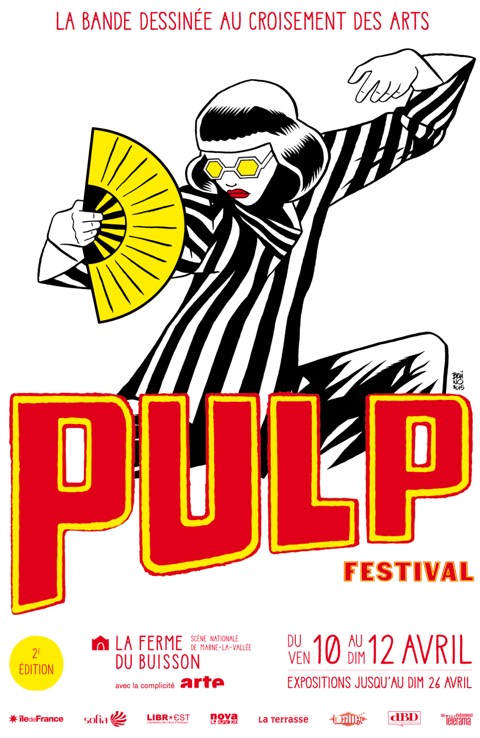Pulp Festival:
Comics Art At The Crossroads

What position do comics occupy today as an art form? All too often, they seem to have been sidelined by galleries, museums and funding bodies. Perhaps it’s symbolic that PULP Festival, which set out in 2014 to reposition comics from the margins to the crossroads with other arts, takes place on the Eastern outskirts of Paris: not far by train but perceptibly distant from the capital’s epicentre. Here, in 1990, a former Menier chocolate factory and dairy farm (built in 1880) were converted into a complex of six theatres, two cinemas and galleries for contemporary art. Since his appointment as director in January 2011, Vincent Eches, a bédéphile himself, began introducing comics into the programming, and last year instigated PULP. ‘I wanted to create a comics event here, but not merely another festival with exhibits and book signings. Working with arts channel Arte, La Ferme du Buisson [below], with its huge facilities, technical possibilities and multiple artistic disciplines being expressed here, brought truly added value to this project.’

Eches ensured that his second PULP Festival from April 10th to 26th 2015 brandished its interdisciplinarity with panache. Transfers from page to stage included Frédéric Sonntag and company’s inventive enactment of the eco-superhero Lichen-Man, originated by Loo Hui Phang and Hugues Micol in their 2005 graphic novel Le prestige de l’uniforme. Broad genre satire was leavened by sharp psychology, as a mediocre scientist experiments on himself, the injected parasite granting him plantlike powers but at the expense of his humanity and sanity. For its low-budget, high-impact climax, a handheld compact camera mounted behind an action figure of our hero filmed him leaping cardboard buildings in a single bound and preventing a model nuclear reactor’s meltdown.

Sm.jpg)
Sm.jpg)
In the main theatre, Swiss director Dorian Rossel’s ensemble STT (Super Trop Top) concluded its touring theatrical production of Jiro Taniguchi’s time-travel manga Quartier lointain (1998–9, translated as A Distant Neighborhood from Fanfare/Ponent Mon). Far superior to the 2010 French movie, STT’s play captures a forty-something salaryman’s confusion and conflicts at finding himself back inside his teenage body and mind with perhaps a chance of stopping his father abandoning his family. It cries out for a revival and a run in Japan.


Contemporary dance also collided and colluded with comics at PULP. In J’ai horreur du printemps, the singular, symbolically loaded atmosphere of Le petit cirque (1973), the travails of a travelling circus by the late cartoonist Fred, were reinterpreted as an acrobatic performance by aerial dancer Mélissa Von Vépy, who scaled, traversed and interacted with projected blowups to a jazz trio accompaniment. A surreal scene in the original, where authorities roll the road up like a carpet, inspired Von Vépy’s entrance, who unwraps herself from coils of fabric.
Sm.jpg)
Sm.jpg)
Sm.jpg)
In Méduses, Belgian street artist Vincent Glowinski, alias Bonom, changes his body into a human brush by daubing white paint across his arms and shoulders, forming gestures that a time-delay camera in the ceiling freezes in ultraviolent light and then projects, so that they accumulate into eerie imagery of a skull, foetus, minotaur or jellyfish.


Méduses - official trailer from Vincent G. on Vimeo.
PULP’s installations proved equally immersive. Artist Ludovic Debeurme conspired with writer Loo Hui Phang to present their embodiment of Edgar Allan Poe’sThe Fall of the House of Usher (1839) in a former farmhouse. Like Poe’s narrator, the visitor pieces together the family’s history from room to room, seven mental spaces in all. Unsettling figures of Madeline open and close this perambulation. Curls of hair grow in through the walls, between portraits, sounds and phrases from the text, none more chilling than a black backdrop with a door in the middle, dividing the words scrawled in white capitals: ‘US’, ‘HER’.




Enfants terribles Florent Ruppert & Jérôme Mulot mounted their first monographic exhibition in a contemporary art centre by making the public physically complicit, posing them in human-scale comics panels as a punctured Saint Sebastian and other playful grotesqueries in La visit des lycées (2015), a gallery ransacked after a chaotic school visit. In an adjacent gallery, Le petit théâtre de l’ébriété gathered their obsessional circular paper constructions, which, as in a phenakistoscope, are rotated by visitors activating a turntable with their foot, spinning their cutout characters into endless drunken cycles.



Another highlight was Bandes Fantômes, assembling some 200 Francophone comics rejected by publishers, abandoned by their authors, censored or destroyed by accident or design. Unrealised, stillborn, ghostlike, these ranged from Caran d’Ache’s 1894 dream of making the first wordless full-length graphic novel to Fabrice Neaud’s fearlessly honest gay autobiography, the subject of lawsuits (see 4th photo below). Alongside surviving drafts and video testimonies, projections of extracts were printed on the reverse of a 60m roll of paper spiralling up to the ceiling, and illuminated sporadically from behind, only to vanish like apparitions.




PULP, however, left a lasting impression of a festival fully engaging with the interconnectedness of comics with other arts and more than lived up to Eches’s ambition ‘to explore new visual and narrative territories by offering the reader-spectator other modes and temporalities to get to grips with comics.’
Below are my PULP Festival video tours of Bandes Fantômes and the Ruppert & Mulot exhibitions, and a demo of the Festival’s drawing-activated music-making machine.
Posted: July 30, 2015
The Article originally appeared in ArtReview magazine, Summer 2015. Press photographs of ‘Lichen-Man’ & ‘J’ai horreur du printemps’ © Pascal Gély.















